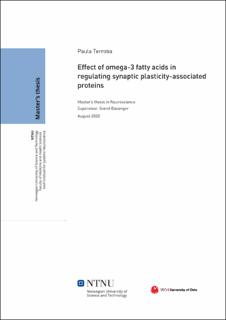| dc.description.abstract | With an increasing number of the population reaching older age, it is important to find lifestyle interventions that may counteract cognitive decline and dementia. Enrichment of diet with omega-3 fatty acids (n-3 PUFAs) has shown promising effects, but little is known about the cellular and molecular mechanisms in the brain. In this project, I have studied the effects of a n-3 PUFA rich diet on the concentrations of functionally important synaptic and glial proteins in normal mice (C57bl/6). This is part of a bigger project where we investigate the neuroprotective mechanisms of n-3 PUFAs on synapses in normal mice and on a mouse Alzheimer model (5xFAD). I have selected 14 different neuronal and glial proteins that are important for synaptic plasticity, and investigated any diet-based changes in their concentrations in the cerebral cortex and the hippocampus. A comparison of the level of these proteins was performed with the Western blot technique on homogenates from the hippocampus and cortex homogenates of mice raised on a diet which was either deficient or rich in the two common omega-3 fatty acids, DHA and EPA. First of all, we observed higher levels of the glutamate receptor subunits: GluA2 and GluN2B in mice fed with n-3 rich PUFA rich diet in both hippocampus and cortex. The GluA1 subunit, however, was reduced in the cortex but not in the hippocampus with the n-3 PUFA rich diet. Furthermore, in the cortex but not in the hippocampus, the synaptic vesicle proteins synaptophysin and synaptotagmin-1 showed higher concentrations in the n-3 PUFA rich group. Lastly, the postsynaptic scaffolding protein, PSD-95, the immediate early gene, Arc/Arg3.1, and the microglia/macrophage-specific calcium-binding protein, Iba1, are all significantly higher in the cortex of omega-3 fatty acid-deficient group, while the astrocyte marker, GFAP, was increased in the cortex of the n-3 PUFA enriched group. There were no significant changes in the glutamate receptor subunits GluN1, or GluN2A, in the neuronal growth factor BDNF, or in the microglial cell marker CD68. Taken together, my results indicate that dietary n-3 PUFAs may play a role in regulating the expression of a number of neuronal and glial proteins that are important for synaptic plasticity. | |
